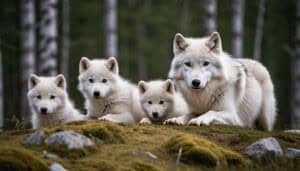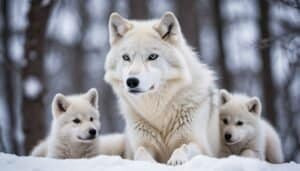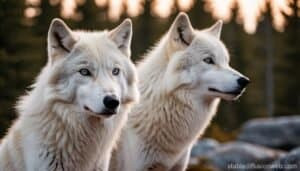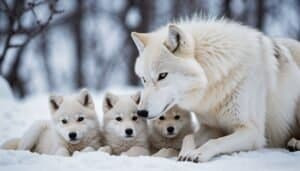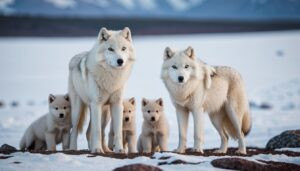Introduction
Arctic wolf pups face a multitude of challenges from the moment they are born. On average, the survival rate of Arctic wolf pups is estimated to be around 50% to 60% during the first year of life. This article delves into the various factors that influence their survival rate, such as climate change, predation, and parental behavior
We will also explore the environmental challenges they encounter, regional variations in their survival rates, and the conservation efforts aimed at protecting these vulnerable creatures. Read on to gain a comprehensive understanding of the survival dynamics of Arctic wolf pups
Factors Influencing the Survival Rate of Arctic Wolf Pups
The survival rate of Arctic wolf pups is affected by several factors that play crucial roles in their early stages of life. Understanding these factors can provide insights into the challenges these animals face and the measures needed to ensure their survival
Climate Change and Its Impact
Climate change significantly impacts the survival rate of Arctic wolf pups. As temperatures rise and ice melts, the natural habitat of the Arctic wolf is altered
This change can lead to a reduction in prey availability, forcing wolf packs to travel greater distances to find food. The increased exertion can be particularly challenging for the young pups, who rely heavily on their parents for sustenance
Moreover, the melting ice and permafrost can lead to habitat loss, reducing the available space for denning and raising pups. This makes the pups more vulnerable to predators and harsh weather conditions
Additionally, unseasonal weather patterns can affect the timing of births and the availability of food resources during critical periods of pup development
Predation and Threats from Other Animals
Predation is another major factor influencing the survival rate of Arctic wolf pups. While adult Arctic wolves are apex predators, their pups are vulnerable to attacks from other predators such as polar bears, eagles, and other wolves
The presence of these predators requires constant vigilance from the pack to protect their young
Competition with other predators for food resources can also indirectly affect pup survival. If food is scarce, adult wolves may not be able to provide enough for their pups, leading to malnutrition and increased mortality rates
Additionally, encounters with other wolf packs can result in territorial disputes, putting the pups at risk during such confrontations
Parental Protection and Behavior
The behavior and protective measures of Arctic wolf parents are critical to the survival of their pups. Arctic wolf packs are known for their strong social bonds and cooperative care of young
The alpha pair typically leads the pack, and both parents, along with other pack members, participate in rearing the pups
Parental protection includes guarding the den site, hunting for food, and teaching the pups essential survival skills. The den is usually located in a concealed and safe area, providing a secure environment for the pups during their early development stages
The pack’s cooperative nature ensures that the pups receive adequate care and protection, significantly increasing their chances of survival
Litter Size and Pup Development
The size of the litter can also influence the survival rate of Arctic wolf pups. Larger litters may lead to increased competition for food and resources among the pups, potentially resulting in lower survival rates
Conversely, smaller litters might ensure that each pup receives more attention and resources from the parents, enhancing their chances of survival
Pup development is another crucial aspect. Arctic wolf pups are born blind and helpless, requiring several weeks of care before they can start exploring their surroundings
The early stages of development are critical, and any health issues or lack of nutrition during this period can have long-term impacts on their survival
Duration of Parental Care
The duration of parental care plays a significant role in the survival of Arctic wolf pups. Typically, pups stay with their parents for about six to eight months, during which they learn vital skills such as hunting, social interaction, and navigation of their environment
Extended parental care ensures that the pups are well-prepared to face the challenges of the Arctic wilderness once they become independent
During this period, the parents and other pack members teach the pups how to hunt and provide them with protection and guidance. The longer the period of parental care, the better equipped the pups are to survive on their own
Inadequate parental care or premature independence can lead to higher mortality rates due to inexperience and lack of skills necessary for survival
Environmental Challenges and Regional Variations
Arctic wolf pups face numerous environmental challenges that can significantly impact their survival rates. These challenges vary across different regions of the Arctic, creating unique conditions for each wolf pack
Food Availability and Scarcity
Food availability is a critical factor in the survival of Arctic wolf pups. The primary prey for Arctic wolves includes musk oxen, Arctic hares, and caribou. The abundance or scarcity of these prey animals can directly influence the health and survival of the pups
In regions where prey is plentiful, Arctic wolf pups have a higher chance of receiving adequate nutrition, which is essential for their growth and development
Conversely, in areas where prey is scarce, competition for food increases, and pups may suffer from malnutrition. This scarcity can be exacerbated by harsh winters, which make hunting even more difficult
Additionally, seasonal fluctuations can affect food availability. During the summer, when prey is more abundant, the survival rates of pups are generally higher. However, in the winter, when food is harder to find, the survival rates can drop significantly
This seasonal variation necessitates that wolf packs adapt their hunting strategies to ensure the continued nourishment of their pups
Impact of Disease and Health Issues
Disease and health issues also play a significant role in determining the survival rates of Arctic wolf pups. Pups are vulnerable to various diseases and parasites, which can be fatal if not properly managed. Common diseases that affect Arctic wolves include rabies, canine distemper, and parvovirus
Parasitic infections from ticks, fleas, and intestinal worms can weaken the pups, making them more susceptible to other illnesses and reducing their overall chances of survival
In regions where veterinary care and wildlife management programs are lacking, these health issues can have a more pronounced impact on pup survival rates
Furthermore, the harsh Arctic environment can exacerbate health problems. Extreme cold, ice, and snow can lead to frostbite and hypothermia, particularly in young pups that are not yet fully developed
The physical stress from these conditions can lower their immune response, making them more prone to infections and diseases
Regional Variations in Survival Rates
The survival rates of Arctic wolf pups can vary significantly across different regions of the Arctic. These variations are influenced by a combination of factors, including climate conditions, prey availability, predation pressure, and human activity
For example, in regions where human encroachment is minimal, and prey is abundant, Arctic wolf pups tend to have higher survival rates
In contrast, areas with higher human activity, such as industrial development or hunting, can disrupt the natural habitat and food sources, leading to lower survival rates
Additionally, some regions may experience more extreme climate conditions, such as longer and harsher winters, which can pose greater challenges for wolf packs and their pups. The adaptability of the wolf pack to these regional conditions plays a crucial role in determining the overall survival rate of the pups
Conservation Efforts and Strategies
Conservation efforts and strategies are essential in ensuring the survival of Arctic wolf pups. Various programs and initiatives aim to protect these vulnerable animals from the numerous threats they face in their natural habitat
Current Conservation Programs
Several conservation programs are currently in place to protect Arctic wolves and their pups. These programs focus on habitat preservation, research, and monitoring, as well as public education and awareness
Habitat preservation is a critical component of conservation efforts. Organizations work to protect the Arctic environment from industrial development, pollution, and other human activities that can disrupt the delicate ecosystem. By safeguarding the natural habitat of the Arctic wolves, these programs help ensure that the wolves have a safe place to live and raise their young
Research and monitoring are also vital. Scientists study Arctic wolf populations to understand their behavior, health, and environmental challenges. This research provides valuable data that can inform conservation strategies and help track the effectiveness of current programs
Monitoring wolf populations helps identify trends and potential threats, allowing for timely interventions
Public education and awareness campaigns aim to increase understanding of the importance of Arctic wolves and the challenges they face. By raising awareness, these campaigns encourage people to support conservation efforts and adopt practices that minimize their impact on the Arctic environment
Future Plans for Protecting Arctic Wolf Pups
Future conservation plans for Arctic wolf pups include expanding protected areas, improving climate change mitigation efforts, and enhancing international cooperation
Expanding protected areas involves designating more regions of the Arctic as wildlife reserves where human activity is restricted. This expansion provides larger, safer habitats for Arctic wolves and other wildlife, reducing the risks posed by human encroachment and habitat destruction
Improving climate change mitigation efforts is crucial for the long-term survival of Arctic wolves. Conservation organizations advocate for policies that reduce greenhouse gas emissions and slow the rate of global warming
These efforts aim to preserve the Arctic environment, ensuring that it remains a viable habitat for Arctic wolves and their pups
Enhancing international cooperation is also a key aspect of future conservation plans. Arctic wolves roam across national borders, making it essential for countries to collaborate on conservation efforts
International agreements and partnerships can facilitate the sharing of research, resources, and best practices, leading to more effective conservation strategies
Role of Wildlife Organizations
Wildlife organizations play a significant role in the conservation of Arctic wolf pups. These organizations work at local, national, and international levels to implement conservation programs, conduct research, and advocate for policies that protect Arctic wildlife
Local wildlife organizations often focus on specific regions, working closely with communities to promote sustainable practices and reduce human-wildlife conflicts. They may also engage in direct conservation activities, such as habitat restoration and anti-poaching efforts
National organizations typically have broader mandates, coordinating conservation efforts across larger areas and advocating for policy changes at the governmental level. They often collaborate with local organizations to support their initiatives and provide additional resources
International wildlife organizations, such as the World Wildlife Fund (WWF) and the International Union for Conservation of Nature (IUCN), work to address global conservation challenges
They facilitate international cooperation, conduct large-scale research projects, and promote conservation policies worldwide
Conclusion
The survival rate of Arctic wolf pups is influenced by a myriad of factors, each playing a crucial role in their development and well-being. From the profound impact of climate change to the dangers posed by predators and environmental challenges, Arctic wolf pups face a tough start to life
Their survival is heavily dependent on the availability of food, the protection provided by their parents, and their overall health during their early months
Understanding these dynamics, conservation efforts are essential. These efforts include habitat preservation, climate change mitigation, and robust research and monitoring programs. Wildlife organizations, both local and international, play pivotal roles in these initiatives, ensuring that Arctic wolf populations are protected for future generations
While the challenges are significant, ongoing and future conservation strategies offer hope. By expanding protected areas, enhancing international cooperation, and raising public awareness, we can help secure a safer and more stable environment for Arctic wolf pups
Through these combined efforts, the resilience of these remarkable animals can be bolstered, ensuring that Arctic wolves continue to thrive in their natural habitats


